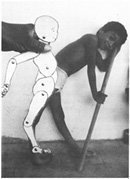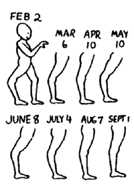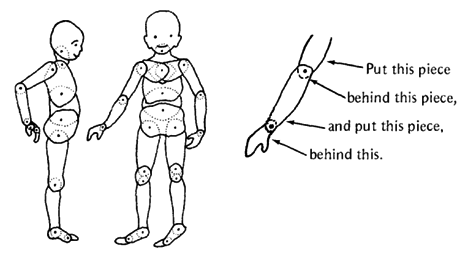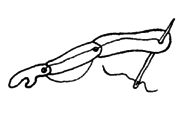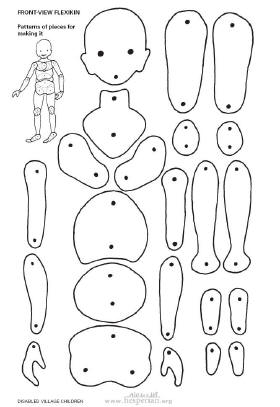043
CHAPTER 5Simple Ways to Measure and Record a Child's ProgressIt is important to keep records of each child's progress. Careful records help workers and parents to follow the change in the individual child, and to evaluate the effectiveness of advice, therapy, and aids. We need a clear view of the progress of the whole child in all areas - physical, mental, and social. The Child Development Chart on Page 292 and 293 will help us to do this for younger children. For children over 5, at the end of this chapter there is a simple chart (RECORD SHEET 5) for evaluating a child's increasing ability to do things. When the parents and child themselves regularly measure and record a child's progress, they become more aware of gradual improvements. This encourages them to continue with important exercises, aids, and activities. Unfortunately, the standard way of recording physical deformities and contractures requires knowledge of angles, degrees, and symbols that many people do not understand. For evaluation to become a family tool, we need a way to measure, record, and interpret information that is as simple, clear, and enjoyable as possible. Here are some ideas. MEASURING JOINT POSITIONS AND CONTRACTURES
|
|||||||||||||||||||||||||||||||||||||||||||||||||||||||||||||||||||||||||||||||||||||||||||||||||||||||||||||||||||||||||||||||||||||||||||||||||||||||||||||||||||||||||||||||||||||||||||||||||||||||||||||||||||||||||||||||||||||||||||||||||||||||||||||||||||||||||||||||||||||||||||||||||||||||||||||||||||||||||||||||||||||||||||||||||||||||||||||||||||||||||||||||||||||||||
|
|
Each month she does the same and records the date. (in April her son did not use the brace for 2 weeks and she saw the knee was getting worse. This convinced both mother and boy of the importance of using the brace.) |
The flexikins can be used to record a wide variety of positions, deformities, contractures, and limitations in range of motion, mainly of the arms and legs but also of the neck, back, hips, and body:
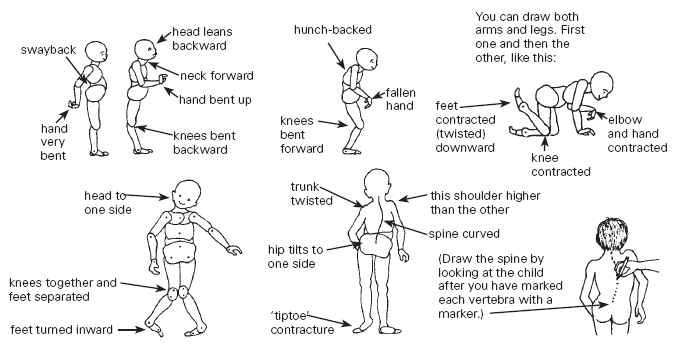
In addition to using the small flexikins for record keeping, you can make large flexikins for group teaching. Or use them to keep body proportions correct when making drawings for instruction sheets.
| Note: For recording contractures, we have found the side-view flexikin more useful than the front-view one. The side-view flexikin is also easier to make. It is probably the only one you will need for evaluating a child's progress. |
How to make the flexikins
1. Trace the patterns of different pieces (Page 47 and 48) onto very thick paper or thin, firm cardboard. Or use old X-ray film.
You can do this using
carbon paper. (Make your own carbon paper by
completely blackening a sheet of paper with a
soft-leaded pencil.) Or you can glue a copy of the pattern sheet directly GLUE to the cardboard. (If your program plans to make many flexikins, or have children make them, we suggest you have the patterns printed or mimeographed directly on sheets of thin, firm cardboard.)
|
 |
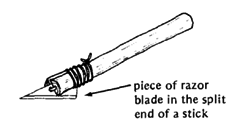 2.
Cut out the pieces with strong scissors, shears, or a
piece of razor blade. 2.
Cut out the pieces with strong scissors, shears, or a
piece of razor blade.
3. Place the pieces together as shown in the drawings. Make sure the pieces that overlap with dotted lines go behind those with complete lines. |
| 4. Fasten the pieces together at the black dots with rivets, pins or thread. | |||
| Use the smallest rivets
you can find.
|
Or string the joints
together with thread or yarn (this does not work as
well).
|
Or use thin wire or
string and tie knots.
|
Or use sewing pins;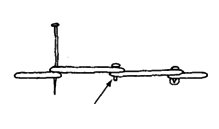 cut here and put a drop of very strong glue (like epoxy) here.
|
Rivets usually work best. First punch a hole through each black dot. Put the rivets through and hammer them just enough so that the cardboard joints are tight enough to hold their positions but can be moved without tearing.
You can copy this sheet, or one like it, and give it to parents together with a flexikin. Be sure that you also show them how to use it and then watch them use it.
| 047 | 048 |
EVALUATING THE PROGRESS OF THE WHOLE CHILD
A simple way for rehabilitation workers and parents to evaluate how a child is progressing as a whole is to keep a record of her ability to do different things. Each month, or during each visit to the community rehabilitation center, the child's different abilities are reviewed, tested, or observed. Any changes are recorded.
For children under 5 years old, one way of evaluating a child's development is to use the RECORD SHEET 6 (Page 292). This chart shows the developmental levels ('milestones') for different skills and activities. The first time the child is evaluated, circle the drawing that shows what the child can do in each area.
Each time the child is evaluated, on the same sheet, again circle the appropriate drawing, but use a different color (or a dotted, dashed, or zigzag line). This way, you can see where the child is moving ahead well and where he is behind.
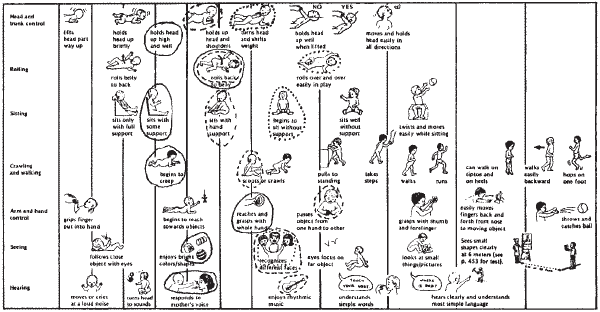
For evaluating the progress of children over age 5, the charts on the next page may help. Two different approaches are used. Chart A is more objective (requires less personal judgment or opinion) but does not allow for small improvements. Chart B is more subjective (is based more on personal judgments). It considers quality of improvement, not just quantity. You can try both and see which you think gives truer, more useful results.
To use Chart A: For each skill,
circle whether the child can do it "without help," "with
a little help," Add all the numbers you circle. Compare
the scores of the first and second visits. For example:
Here we see the child has improved his eating skills but not his drinking skills.
To use Chart B: In each area, on the second visit, circle whether the child is doing a lot better, a little better, or the same. Add it all up. The higher the score, the more the child has improved.
| NOTE: We question whether the use of numbers may not be misleading. But we think the questions themselves may be a useful guideline. None of these evaluation forms will show all areas of change or improvement. They are not substitutes for detailed notes, drawings, and a good memory! |
 EVALUATION
OF PROGRESS - CHILD OVER AGE 5
EVALUATION
OF PROGRESS - CHILD OVER AGE 5
| Name _____________ | Age________ | Disability ______ | ||||
| CHART A | First visit (date______ ) | Second visit (date______) | ||||
| Daily activities | without help | little help | lots of help | without help | little help | lots of help |
| Feeding | ||||||
| 1 . How does the child eat? | 4 | 2 | 0 | 4 | 2 | 0 |
| 2. How does the child drink? | 4 | 2 | 0 | 4 | 2 | 0 |
| Dressing and washing | ||||||
| 3. Does child wash face and body? | 4 | 2 | 0 | 4 | 2 | 0 |
| 4. Does child dress? | 4 | 2 | 0 | 4 | 2 | 0 |
| 5. Does child put on orthopedic equipment? | 4 | 2 | 0 | 4 | 2 | 0 |
| Bowel and bladder care and control | ||||||
| 6. Does child stay clean (bowel control)? | 4 | 2 | 0 | 4 | 2 | 0 |
| 7. Does child clean herself after shitting? | 4 | 2 | 0 | 4 | 2 | 0 |
| 8. Does child stay dry during the day? | 4 | 2 | 0 | 4 | 2 | 0 |
| 9. Does child stay dry at night? | 4 | 2 | 0 | 4 | 2 | 0 |
| Mobility/transfers | ||||||
| 10. Does child move from chair to bed and back? | 4 | 2 | 0 | 4 | 2 | 0 |
| 11. Does child move from floor to bed and back? | 4 | 2 | 0 | 4 | 2 | 0 |
| Movement | ||||||
| 12. Walks on flat surface? | 4 | 2 | 0 | 4 | 2 | 0 |
| 13. Walks on uneven surface? | 4 | 2 | 0 | 4 | 2 | 0 |
| 14. Climbs up and down stairs? | 4 | 2 | 0 | 4 | 2 | 0 |
| 15. Uses a wheelboard or wheelchair? | 4 | 2 | 0 | 4 | 2 | 0 |
| 16. Does child crawl? | 4 | 2 | 0 | 4 | 2 | 0 |
| Social activities/communication | ||||||
| 17. Does child help with housework or farm work? | 4 | 2 | 0 | 4 | 2 | 0 |
| 18. Does child play with other children? | 4 | 2 | 0 | 4 | 2 | 0 |
| 19. Does child go to school? | 4 | 2 | 0 | 4 | 2 | 0 |
| 20. Does child speak? | 4 | 2 | 0 | 4 | 2 | 0 |
| 21. Does child communicate with signs or gestures? | 4 | 2 | 0 | 4 | 2 | 0 |
| Total ________ | Total ________ | |||||
| CHART B | First visit |
Second visit |
|||
| Quality of activities | make notes for comparison here | much better | a little better | same | worse |
| Does child move about better? | 4 | 2 | 0 | -4 | |
| Does he sit in a better position? | 4 | 2 | 0 | -4 | |
| Does he walk better (straighter, with less limp, or with less support)? | 4 | 2 | 0 | -4 | |
| Does he walk farther, faster, or easier? | 4 | 2 | 0 | -4 | |
| Are his joints straighter (less contractures)? | 4 | 2 | 0 | -4 | |
|
4 | 2 | 0 | -4 | |
|
4 | 2 | 0 | -4 | |
|
4 | 2 | 0 | -4 | |
| Can the child do things he could not do before? | 4 | 2 | 0 | -4 | |
|
4 | 2 | 0 | -4 | |
|
4 | 2 | 0 | -4 | |
|
4 | 2 | 0 | -4 | |
|
4 | 2 | 0 | -4 | |
| Does he play with things better? | 4 | 2 | 0 | -4 | |
| Does he speak or communicate better? | 4 | 2 | 0 | -4 | |
| Does he get along with other children better? | 4 | 2 | 0 | -4 | |
| Does he seem happier or more self-confident? | 20 | 8 | 0 | -4 | |
| Has he improved or got worse in other ways? | 4 | 2 | 0 | -4 | |
|
4 | 2 | 0 | -4 | |
| Total ________ | |||||

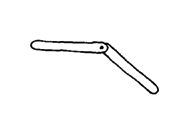
 2.
Line them up exactly with the joint.
2.
Line them up exactly with the joint. 3.
Trace the angle on paper.
3.
Trace the angle on paper. 4.
Do this again every 1 or 2 weeks to see if the joint is
straightening with exercise.
4.
Do this again every 1 or 2 weeks to see if the joint is
straightening with exercise.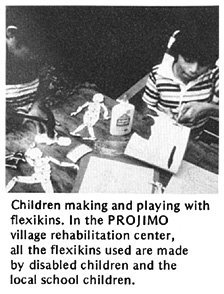 The
'flexikin'- an aid to measure and encourage progress
The
'flexikin'- an aid to measure and encourage progress


